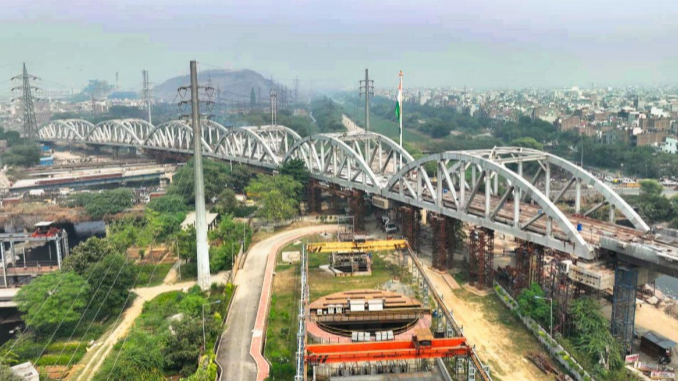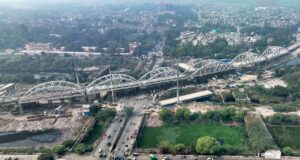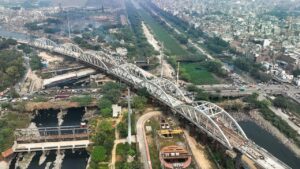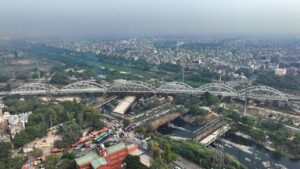
NCRTC has completed the installation of all six special steel spans for the Delhi section of the RRTS corridor successfully. These special steel spans have been established to cross the Gazipur Drain and Kondli roundabout from New Ashok Nagar towards Anand Vihar.

More Details:
These steel spans have been installed one after the other, making it the only place on the entire RRTS corridor where such a long viaduct is being constructed with special steel spans.
The combined length of these 6 special steel spans is around 360 metres. RRTS corridor coming from Sarai Kale Khan and moving parallelly towards Gazipur Drain, has now crossed over the drain with the installation of these six steel spans.
Out of these 6 special steel spans, the length of 3 spans is approximately 70 metres long each with each weighing 540 tonnes and the remaining 3 are 50 metres long each with each weighing 540 tonnes. These special steel spans are about 14 metres wide.
The installation of the steel span near the Ghazipur drain, which is about 40 to 50 metres wide, was a challenging task because it flows diagonal to the alignment of the RRTS corridor. Due to the flowing drain, the deep foundation for the pillars had to be made in the drain.

Key Challenges During Work:
- Moreover, existing structures of PWD roads and large DJB pipelines created hindrances and high-capacity cranes had to be used for the construction of the foundation. The site was also in the close vicinity of the high-tension EHT lines, adding to the challenges. Despite these difficult situations, Team NCRTC completed it successfully following all the norms and taking all the precautions.
- These steel spans have been installed on the pillars constructed for the same and a little ahead of these spans in the direction of Khichripur, an underground ramp is being constructed, which will connect this elevated section to the underground Anand Vihar Station via Underground tunnels.
NCRTC usually erect pillars at an average distance of 34 metres for the construction of an elevated viaduct of the RRTS corridor. These pillars are joined by precast segments with the help of a launching gantry (Tarini) to form the RRTS viaduct span.

However, in some complex areas where the corridor crosses rivers, bridges, rail crossings, metro corridors, expressways or other such existing infrastructure, it is practically not possible to maintain this distance between pillars. In such areas, steel spans are being used to connect the pillars.
With the installation of these 6 special steel spans, the number of special steel spans installed so far in the 70 km long elevated section of the 82 km long Delhi-Ghaziabad-Meerut RRTS corridor has increased to 12.
- Earlier, 6 special steel spans were installed for the Delhi-Meerut RRTS corridor, including one span at Meerut on the Delhi-Meerut Expressway (DME), one special span at Vasundhara on the main line of the railway, one Steel Span Near Ghaziabad station, two steel spans for RRTS viaduct going towards Duhai Depot and one span for crossing EPE.
- Special steel spans are massive structures, consisting of beams made of structural steel. NCRTC first manufactures the segments of structural steel in the factory and then laden them onto trailers to bring them to the site during the night to avoid any traffic problems.
These parts are then assembled at the site by systematically joining together with the help of a special process. The shape and structure of these steel spans are specially designed to suit all the requirements of construction, installation and usage.
Source: NCRTC- Press Release | Images Credit: NCRTC

